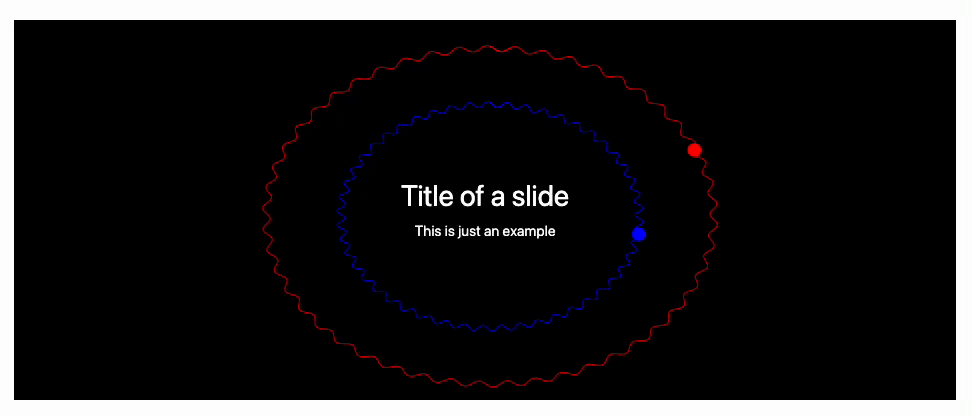Backgrounds
There is a few way on how you can put a background image for your slides
Global settings
You can apply it for all slides by redefining .reveal class name
.wlx
<style>
.reveal {
background: black;
color: white;
}
</style>
now the default background is black
.slide
# Hey, I am Black!
It will not work to a projected output cell
Local control
Using RevealJS data attributes, one can specify the background for each slide individually
.slide
<!-- .slide: data-background-color="black" -->
<!-- .slide: style="color:white" -->
# Hey, I am black
Dynamic background
One can put a giant Graphics or Graphics3D or Image element to the background of your slide. For this reason you need to add some CSS in order to position them properly with a content
The standard size of a slide is 960x700
Let us firstly make a draft of our component
.wlx
BackImageDynamic := Module[{
frameEvent = CreateUUID[],
animationEvent = CreateUUID[],
slideEvent = CreateUUID[],
allowedQ = False,
trigger = 1
}, With[{
Canvas = Graphics[{
Black, Rectangle[{0,0}, {1,1}], Red,
curveDynamicGenerator[{0.5,0.5}, 0.8, animationEvent], Blue,
curveDynamicGenerator[{0.5,0.5}, 0.3, animationEvent],
AnimationFrameListener[trigger // Offload, "Event"->frameEvent]
}, "Controls"->False, ImagePadding->0, TransitionDuration->200, ImageSize->{960,700}, PlotRange->{{0,1}, {0,1}}]
},
EventHandler[frameEvent, Function[Null,
If[!allowedQ, Return[]];
If[Mod[trigger, 5] == 0, EventFire[animationEvent, True]];
trigger = trigger + 1;
]];
EventHandler[slideEvent, {
"Slide" -> Function[Null,
allowedQ = True;
trigger = trigger + 1;
Print["Animation started"];
],
("Destroy" | "Left") -> Function[Null,
allowedQ = False;
Print["Animation stopped"];
]
}];
<div>
<SlideEventListener Id={slideEvent}/>
<Canvas/>
</div>
] ]
Here, we artificially slow down the Kernel's responses using the trigger variable by a factor of 5, so that our background doesn't consume too many resources. Interpolation on the browser side with TransitionDuration->200 is usually a bit "cheaper." Another concern is not to waste CPU resources, when the slide is not shown, that we solve using allowedQ symbol.
curveDynamicGenerator will be our animated fragment
curveDynamicGenerator[center_, radius_, ev_] := With[{},
Module[{
pts = Table[Norm[center - radius] {Sin[i], Cos[i]} +
center, {i, 0, 2 Pi + 0.1, 0.1}],
disk = {10,10},
modulation = 0.,
phase = 0.,
initial = 12. RandomInteger[{0,10}]
},
EventHandler[EventClone[ev], Function[Null,
pts = Table[(
Norm[center - radius]
+ 0.02 modulation Sin[50. i + 30 phase]
) {Sin[i], Cos[i]} + center
, {i, 0, 2 Pi + 0.1, 0.01}];
disk = With[{i = 3. phase + initial},
(Norm[center - radius]
+ 0.01 modulation Sin[50. i + 30 phase]
) {Sin[i], Cos[i]} + center
];
phase = phase + 0.02;
modulation = Sin[phase/2];
]];
{
Line[pts // Offload],
Disk[disk // Offload, 0.013]
}
]]
To make sure that the slide heigh is 100% of the window, add the attribute
.slide
<!-- .slide: style="height:100%" -->
Let's place our background on the slide and ensure it doesn't take up space there using the position property in CSS.
.slide
<!-- .element: data-background-color="black" -->
<!-- .slide: style="height:100vh; color: white;" -->
<div class="flex flex-col h-full">
<div class="absolute w-full h-full" style="scale: 1.1; left:-30px; z-index:-100">
<BackImageDynamic/>
</div>
<div class="mt-auto mb-auto">
# Procedural background
It will be animated till slide is visible
</div>
</div>
---
<!-- .element: data-background-color="black" -->
<!-- .slide: style="height:100vh; color: white;" -->
Now the animation stops
Demonstration
